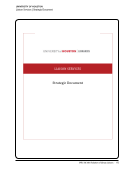94 · Survey Results: Survey Questions and Responses
Provides subject expertise and research support to students and faculty. Assures that materials obtained by the library
are relevant and useful to students and faculty. Enriches teaching and learning experiences of students and faculty
through collaboration and use of library resources.
Researchers and students have one point person for all their library needs. Provide expertise that can help support the
research lifecycle. Reduce the burden of researchers by saving them time.
Responsive and tailored library services and resource to our various communities of users across the disciplines.
Improved funding to support library services, facilities, and staffing. Development of an informed information literacy
program that mirrors priorities of the university’s strategic initiatives.
Simplify a complex library system by providing single-person first point of contact. Better understanding of individual
faculty needs, priorities, pain points. Opportunities to engage with faculty and departments to better understand how
to structure library services.
Strengthens ties between the library and the community. Allows for currency of service provision and ensures we are
providing excellent and relevant service. Integrates information literacy into the intellectual fabric of the university.
Subject Librarian Framework helps ensure that we provide a standard and equitable set of services to all departments.
Two-way pipeline for communication.
Support for research, teaching, and learning. Establishes stronger ties between the library and the academic units. Aids
in communicating the library’s contribution to the university mission.
Support the university’s academic mission to improve student experience and research outcomes. Dramatically increases
the Libraries’ visibility and collaboration with “new” areas and initiatives across campus. Liaison program facilitates the
Libraries’ ability to be a change agent across campus.
Supporting university mission. Make sure collections meet needs for research and teaching. Fulfillment that comes when
librarians integrate into the research and learning community.
Various user groups have a primary point of contact in the library. Library is more responsive to user needs because of
their partnerships and relationships. Raises our profile as active, engaged members of the campus community.
Visibility of library services and resources on campus. Increased usage of library resources and materials. Awareness of
needs of stakeholders.
43. Please describe up to three top challenges for your library liaisons. N=61
Attracting and retaining language expertise.
Balancing workload both overall and within the number of departments a liaison is assigned to serve. Funding to
support library initiatives that include participation and support by subject specialists. Better tracking and assessment of
liaison activities, best practices, and effectiveness.
Balancing the needs of subject- and function-based expertise. Ensuring librarians have knowledge, expertise, skills
needed for new liaison areas in a timely way.
Building relationships with busy faculty. Quantitative demand for teaching and consultation services. Broad range of
subjects needing to be covered by a limited number of staff.
Provides subject expertise and research support to students and faculty. Assures that materials obtained by the library
are relevant and useful to students and faculty. Enriches teaching and learning experiences of students and faculty
through collaboration and use of library resources.
Researchers and students have one point person for all their library needs. Provide expertise that can help support the
research lifecycle. Reduce the burden of researchers by saving them time.
Responsive and tailored library services and resource to our various communities of users across the disciplines.
Improved funding to support library services, facilities, and staffing. Development of an informed information literacy
program that mirrors priorities of the university’s strategic initiatives.
Simplify a complex library system by providing single-person first point of contact. Better understanding of individual
faculty needs, priorities, pain points. Opportunities to engage with faculty and departments to better understand how
to structure library services.
Strengthens ties between the library and the community. Allows for currency of service provision and ensures we are
providing excellent and relevant service. Integrates information literacy into the intellectual fabric of the university.
Subject Librarian Framework helps ensure that we provide a standard and equitable set of services to all departments.
Two-way pipeline for communication.
Support for research, teaching, and learning. Establishes stronger ties between the library and the academic units. Aids
in communicating the library’s contribution to the university mission.
Support the university’s academic mission to improve student experience and research outcomes. Dramatically increases
the Libraries’ visibility and collaboration with “new” areas and initiatives across campus. Liaison program facilitates the
Libraries’ ability to be a change agent across campus.
Supporting university mission. Make sure collections meet needs for research and teaching. Fulfillment that comes when
librarians integrate into the research and learning community.
Various user groups have a primary point of contact in the library. Library is more responsive to user needs because of
their partnerships and relationships. Raises our profile as active, engaged members of the campus community.
Visibility of library services and resources on campus. Increased usage of library resources and materials. Awareness of
needs of stakeholders.
43. Please describe up to three top challenges for your library liaisons. N=61
Attracting and retaining language expertise.
Balancing workload both overall and within the number of departments a liaison is assigned to serve. Funding to
support library initiatives that include participation and support by subject specialists. Better tracking and assessment of
liaison activities, best practices, and effectiveness.
Balancing the needs of subject- and function-based expertise. Ensuring librarians have knowledge, expertise, skills
needed for new liaison areas in a timely way.
Building relationships with busy faculty. Quantitative demand for teaching and consultation services. Broad range of
subjects needing to be covered by a limited number of staff.












































































































































































































